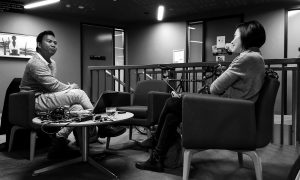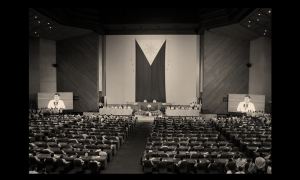There’s an interest in reading the Philippines. Some of us are just unsure where to start.
As a teacher of Sociology with an active social media presence, I often get asked for suggestions on what to read about Philippine society, culture, and politics. When I made a Twitter thread of my reading list, I did not expect it to go viral. There seems to be a demand to understand the Philippines beyond the world of fake news and hot takes.
This list is a response to the challenge of doing slow reads in a fast-paced world. Discussion points may continue to change but the idiosyncrasies of the Philippines, a Southeast Asian archipelagic nation-state of over 7,600 islands, still remain as they were in the past.
Organised chronologically based on the historical contexts of the readings, this list includes: what the reading is all about, who might find it useful, and the debates and further lines of inquiry it opens.
1. Scott, William Henry. 1994. Barangay: Sixteenth-Century Philippine Culture and Society. Quezon City: Ateneo de Manila University Press.
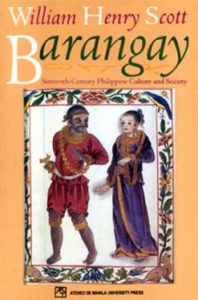 Few academic text focuses solely on pre-colonial Philippines. This book still answers the call. It offers ethnographic material showing the habits of the people before their colonisation and before the influence of some contemporary major religions such as Islam and Catholicism.
Few academic text focuses solely on pre-colonial Philippines. This book still answers the call. It offers ethnographic material showing the habits of the people before their colonisation and before the influence of some contemporary major religions such as Islam and Catholicism.
Scott’s main agenda, however, is to present how the Spaniards saw the Philippine islanders and what the Spaniards said about the inhabitants of their new-found colony. Traditions that come across as barbaric in today’s standards are situated in their historical context, such as skull moulding of infants to give way to a flat forehead and a flat nose. This book is useful to scholars who want a glimpse of the uncolonised ancestors’ identity construction and community life, and see how they were changed by the colonizing process.
2. Ileto, Reynaldo Clemeña. 1979. Pasyon and Revolution: Popular Movements in the Philippines, 1840-1910. Quezon City: Ateneo de Manila University Press.
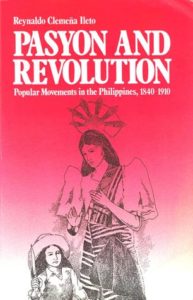 In this book, Ileto offered a fresh take on the revolution against the Spaniards, centering on the revolution from below—those by peasant brotherhoods. Earlier historical analyses have focused on the role of the elite and middle classes in the revolution, but this book examines not only movements orchestrated by the peasants, but also the peasants’ ideas on, and the meanings they attribute to, the revolution.
In this book, Ileto offered a fresh take on the revolution against the Spaniards, centering on the revolution from below—those by peasant brotherhoods. Earlier historical analyses have focused on the role of the elite and middle classes in the revolution, but this book examines not only movements orchestrated by the peasants, but also the peasants’ ideas on, and the meanings they attribute to, the revolution.
Ileto finds that their recognition is grounded on their view and lived experience of the Pasyon, a lengthy poem about the birth, life, and death of the savior Jesus Christ. This poem is sung and chanted in many provinces in the Philippines during Holy Week. A mixture of religious dogmas and indigenous traditions have allowed the peasants to see the Pasyon in a revolutionary lens, one of which is the belief on the efficacy of anting–anting, an amulet that gives extraordinary abilities to its wearer.
This book cites some parallelisms of the Bible to the situations in colonial Philippines under the Spaniards. Examples of this are the struggles of Jesus Christ in comparison to the struggles of separatist movement leaders, and the estrangement of the Anointed Son and the Holy Mother in comparison to the separation of the Philippines from Spain. This book is useful especially to those interested in the religious character of the Philippines.
3. Constantino, Renato. 1970. “The Mis-Education of the Filipino.” Journal of Contemporary Asia1(1):20-36.
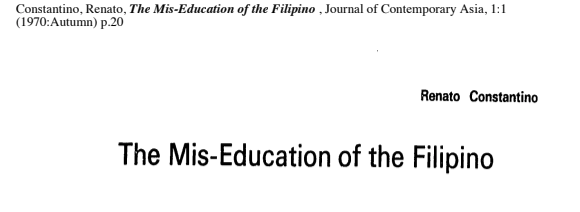 This journal article problematises the Philippine educational system, particularly the dominance of the English language and the propagation of American standards and ideals in schools. Constantino asserted that when the Americans introduced public education in the Philippines, they assumed that the making of an educated Filipino was equal to the making of an educated American—an assumption that can be accepted if and only if the Philippines and America had the same economic and political goals and were at the same economic and political level.
This journal article problematises the Philippine educational system, particularly the dominance of the English language and the propagation of American standards and ideals in schools. Constantino asserted that when the Americans introduced public education in the Philippines, they assumed that the making of an educated Filipino was equal to the making of an educated American—an assumption that can be accepted if and only if the Philippines and America had the same economic and political goals and were at the same economic and political level.
As a result, Filipinos were forced to understand themselves and their society through the eyes of an outsider, a phenomenon that has crucial implications for today’s foreign policies and national consciousness. The article highlights that the goal of education should be the making of an individual so that s/he may contribute well to the society. This implies that the Philippines should have a system of education that is of the Filipino, for the Filipino. This is a sure treat to readers keen on scrutinising Filipino education and modes of thinking.
4. Ileto, Reynaldo Clemeña. 2005. “Philippine Wars and the Politics of Memory.” Positions: East Asia Cultures Critique13(1):215–35.
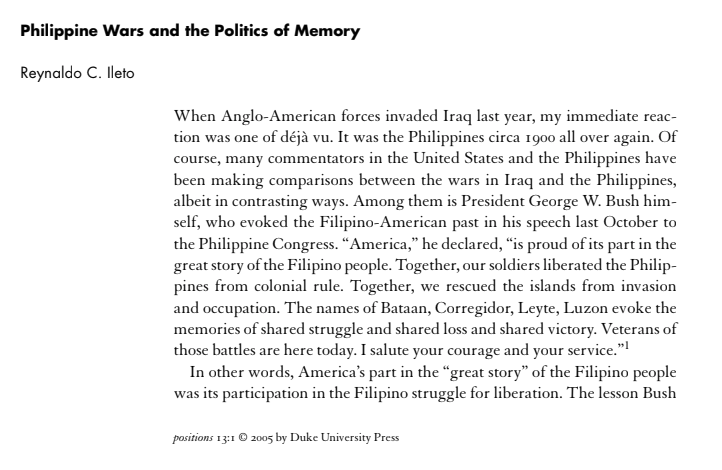 In this brief examination of Philippine history, Ileto outlined what he termed as the five wars namely: war of independence from Spain, Filipino-American war (also known as Philippine insurrection), war with Japan, war against the Huks and other movements led by the radical left, and Moro wars.
In this brief examination of Philippine history, Ileto outlined what he termed as the five wars namely: war of independence from Spain, Filipino-American war (also known as Philippine insurrection), war with Japan, war against the Huks and other movements led by the radical left, and Moro wars.
Ileto argues that these seemingly disparate wars are united by a single theme—resistance against a foreign dominator. However, due to the kind of education made available by the Americans that is still practiced up to this point, Filipinos are led to forget about the Filipino-American war and to misrecognise the Moro wars. This forgetting and misrecognition are the reasons Filipinos today have an incomplete view of their history, which has problematic consequences on how they interpret contemporary events sweeping the country. The enthusiast of historical framing will find this article helpful.
5. Mulder, Niels. 1997. “Filipino Images of the Nation.” Philippine Studies45(1):50–74.
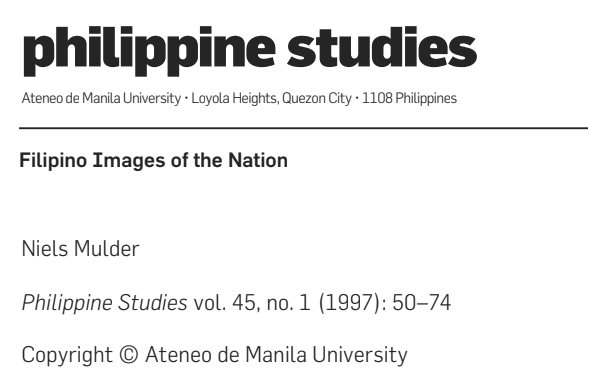 This article is a primer on how Filipinos view themselves. Mulder examined the self-flagellating tendencies of Filipinos and argued that what keeps the country’s low self-esteem are: colonial mentality, dependence on the United States, selfish interest of politicians, non-institutional approach to problems, and excessive emphasis on individual morality. He also presented the curious phenomenon of Filipinos having rootless assumptions of their superiority in Asia but have optimistic inferiority complex towards America.
This article is a primer on how Filipinos view themselves. Mulder examined the self-flagellating tendencies of Filipinos and argued that what keeps the country’s low self-esteem are: colonial mentality, dependence on the United States, selfish interest of politicians, non-institutional approach to problems, and excessive emphasis on individual morality. He also presented the curious phenomenon of Filipinos having rootless assumptions of their superiority in Asia but have optimistic inferiority complex towards America.
Mulder flagged that the Philippines needs a complete overhaul of cultural systems and must start from scratch because of the distortions of people’s collective memory, absence of positive imagination of the public sphere, cultural destruction of the Marcos regime, disinterest of the central state in nation-building, and even clumsiness of the social science curriculum.
6. McCoy, Alfred W., ed. 1994. Anarchy of Families: State and Family in the Philippines. Madison City: University of Wisconsin-Madison Center for Southeast Asian Studies.
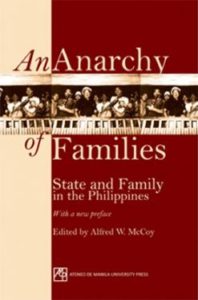 This book is for those who are curious about corruption and power grabbing of politicians in the Philippines. It provides a glimpse of the different strategies used by political dynasties in the Philippines to stay in power, and the different mechanisms by which they mobilise their resources to gain votes.
This book is for those who are curious about corruption and power grabbing of politicians in the Philippines. It provides a glimpse of the different strategies used by political dynasties in the Philippines to stay in power, and the different mechanisms by which they mobilise their resources to gain votes.
McCoy showed the violent and fraudulent nature of the Philippine political arena where elite families continue to dominate. He also stressed that one should not forget to look at the oligarchy endemic in the Philippines if one wishes to understand Philippine history.
Elite families have always been a constant in the Philippines, from being the pre-colonial Maharlika, to the Spanish colonisation’s Gobernadorcillos and Ilustrados, and to the political dynasties brought forth by American electoralism. These families have always been present and have betrayed the Filipino people many times before. In the contemporary Philippine society, McCoy cited warlordism and rent-seeking as the most prevailing strategies for power maintenance.
This book also includes case studies, written by book contributors, of different provinces in the Philippines with various political families exercising different approaches to consolidating their reign.
7. Fallows, James. 1987. “A Damaged Culture: A New Philippines?” The Atlantic.
 Are the Marcoses always at fault? This article thinks not.
Are the Marcoses always at fault? This article thinks not.
Fallows explored how Filipino culture, above all, broke the promise of the EDSA People Power 1 Revolution that ended the dictator Ferdinand Marcos’s rule. After the revolution, Filipinos were positive that all that was wrong with the Philippines will change, only to be kept waiting more than three decades on. Fallows asserted that although a lot of Filipinos see Marcos as the be-all and end-all of all that is rotten in the country, Marcos merely intensified them. It is true that the Marcos era is marked with wealth inequality, corruption, monopolies, and land-ownership disputes but these problems have already existed long before the strongman took power.
Culture, Fallows said, is the culprit. This damaged culture started from the inferiority inculcated by the Spaniards to the mainstream consciousness and continued when the Americans did not allow Filipinos to finish their revolution against Spain. Fallows zeroed in on some of the problematic Filipino cultural phenomena such as love for religious icons, lack of nationalism, and electing the least evil politician instead of the most competent one.
There are lots of Filipinos who thrive outside of their culture, making it no wonder that in the Philippines, the national ambition is to change one’s nationality. This reading is appropriate to those who are wondering what keeps the country poor.
8. Constable, Nicole. 1997. Maid to Order in Hong Kong: Stories of Migrant Workers in Hong Kong. New York: Cornell University Press.
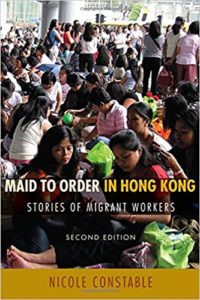 This book presents tales of female overseas Filipino workers (OFWs) in relation to the capitalist world system that has put pressure on developing regions of South and Southeast Asia to answer to the demands of the international care chain.
This book presents tales of female overseas Filipino workers (OFWs) in relation to the capitalist world system that has put pressure on developing regions of South and Southeast Asia to answer to the demands of the international care chain.
Over 120,000 Filipinas aged 20 to 40, some with college degrees and others with high school diplomas, have entered into two-year contracts in Hong Kong. In her analysis, Constable investigated factors such as the interest of both Philippine and Chinese governments that benefit from the foreign capital generated by the flow of human resources; recruitment and placement agencies in the Philippines that have made responding to the need for unskilled workers abroad their mission and business venture; and employers who provide not only salary but also housing arrangements to OFWs in Hong Kong.
These factors all actively contribute to disciplinary measures aimed at perfecting the docility of OFWs, extending to their private lives—their emotions, ambitions, voice, and body. But women are not powerless. The book demonstrates how women assert their power in different ways, from legal avenues and public demonstrations to seemingly trivial and everyday jokes.
9. Mojares, Resil B. 2008. Brains of the Nation: Pedro Paterno, T.H. Pardo De Tavera, Isabelo De Los Reyes and the Production of Modern Knowledge. Quezon City: Ateneo de Manila University Press.
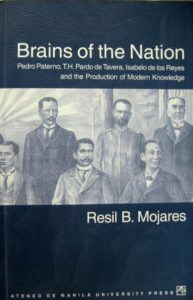 This book traces the evolution of the Filipino thought by looking at the changes in ideologies and aspirations of some of the Ilustrados. It as well presents how Philippine history was understood and written about by Filipinos as early as the 19th Century. Mojares, newly-named National Artist for Literature, deviated from the penchant of other historical writings to focus on Rizal and mention other Ilustrados only when they come incidental to the life and writings of Rizal. Mojares identified three Ilustrados who he claimed had been glossed over in the construction of national historical viewpoints. Pedro Paterno is disparaged as the original balimbing, the political butterfly who changed allegiance based on convenience; T.H. Pardo de Tavera has been downplayed since his cooperation with the Americans; and Isabelo de los Reyes had been devalued following his involvement in the Philippine Independent Church.
This book traces the evolution of the Filipino thought by looking at the changes in ideologies and aspirations of some of the Ilustrados. It as well presents how Philippine history was understood and written about by Filipinos as early as the 19th Century. Mojares, newly-named National Artist for Literature, deviated from the penchant of other historical writings to focus on Rizal and mention other Ilustrados only when they come incidental to the life and writings of Rizal. Mojares identified three Ilustrados who he claimed had been glossed over in the construction of national historical viewpoints. Pedro Paterno is disparaged as the original balimbing, the political butterfly who changed allegiance based on convenience; T.H. Pardo de Tavera has been downplayed since his cooperation with the Americans; and Isabelo de los Reyes had been devalued following his involvement in the Philippine Independent Church.
These three Ilustrados, dubbed by the author as the “three figures of Filipino enlightenment”, are part of the generation that started the consciousness of the Filipino in terms of their identity. Mijares also effectively shows the agreements and disagreements among these Ilustrados themselves, making this book worthwhile for those who want to look at the beginnings of Filipino intellectualism.
10. Medina, Belen T. G. 2015. The Filipino Family. Third ed. Quezon City: University of the Philippines Press.
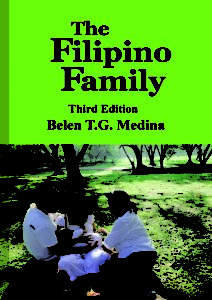 A striking feature of the Filipino culture is the primacy of the family as a unit of analysis. This book examines the constitution of the Filipino family and discusses its definition, selection of romantic partners, courtship, love and sex, role of members, and decision-making, among others. Medina employed the sociological perspectives of structural functionalism, symbolic interactionism, feminism, and postmodernism in her inquiry into the Filipino family.
A striking feature of the Filipino culture is the primacy of the family as a unit of analysis. This book examines the constitution of the Filipino family and discusses its definition, selection of romantic partners, courtship, love and sex, role of members, and decision-making, among others. Medina employed the sociological perspectives of structural functionalism, symbolic interactionism, feminism, and postmodernism in her inquiry into the Filipino family.
The latest edition of the book includes new takes on some emerging phenomena brought about by a fast-changing world. These additions cover relationships engendered online, courtship via social media, and deconstruction of the traditional view of family as composed of the father, the mother, big sister, big brother, and bunso (youngest), and the roles ascribed to each family member. While the analysis of the book is limited only to the middle-class families in lowland urban Christian communities, this book still provides a preview of what can be considered the most important social institution of the nation.
11. Lara, Francisco J. 2014. Insurgents, Clans, and States: Political Legitimacy and Resurgent in Muslim Mindanao, Philippines. Quezon City: Ateneo de Manila University Press.
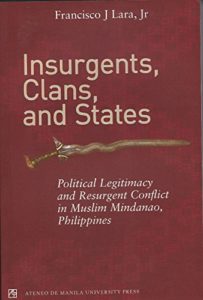 This book discusses the conflict espoused by the neglect and marginalisation of the Mindanao economy. This neglect was appropriated by local politicians, which ultimately enabled them to subvert the legitimacy of Muslim separatist movements such as the Moro National Liberation Front and the Moro Islamic Liberation Front at the very time that parts of Muslim Mindanao gained autonomy from the state. Although Mindanao still contribute to the Manila-centric Philippine economy, it cannot be denied that business ventures in the region are under the shadow economy. This type of economy lays the groundwork for local elites and powerful clans to navigate the weak Philippine state and negotiate with national politicians for rents. Consequently, this book also examines how local politicians may regard peace as a threat to their power and interest since their claim to legitimacy is based on their ability to monopolise the repository of security. This reading is helpful for those concerned with sub-national state building and its auxiliary violence.
This book discusses the conflict espoused by the neglect and marginalisation of the Mindanao economy. This neglect was appropriated by local politicians, which ultimately enabled them to subvert the legitimacy of Muslim separatist movements such as the Moro National Liberation Front and the Moro Islamic Liberation Front at the very time that parts of Muslim Mindanao gained autonomy from the state. Although Mindanao still contribute to the Manila-centric Philippine economy, it cannot be denied that business ventures in the region are under the shadow economy. This type of economy lays the groundwork for local elites and powerful clans to navigate the weak Philippine state and negotiate with national politicians for rents. Consequently, this book also examines how local politicians may regard peace as a threat to their power and interest since their claim to legitimacy is based on their ability to monopolise the repository of security. This reading is helpful for those concerned with sub-national state building and its auxiliary violence.
12. Curato, Nicole, ed. 2017. A Duterte Reader: Critical Essays On Rodrigo Duterte’s Early Presidency. Quezon City: Ateneo de Manila University Press.
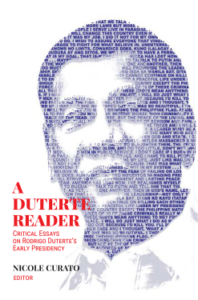 Perhaps a lot of intellectuals out there are developing interest on the Philippines as a result of the controversies surrounding the country’s president and his main political agenda. This book is composed of critical essays from Philippine scholars of various specialisations encompassing topics from Duterte’s rise to power, to the issues that arose in his early presidency.
Perhaps a lot of intellectuals out there are developing interest on the Philippines as a result of the controversies surrounding the country’s president and his main political agenda. This book is composed of critical essays from Philippine scholars of various specialisations encompassing topics from Duterte’s rise to power, to the issues that arose in his early presidency.
This is an essential reading for those who want to have a comprehensive view on Duterte’s rise to power. This anthology, simply put, places Duterte in context. It explores Dutertismo and asserts that when one talks about Duterte, one does not only talk about his eccentric manners and personality as a President, but also the different institutions and cultural traditions that made his rise possible and that continue to cradle his presidency.
The need to talk about Rodrigo Duterte, the first president to ever come from Philippine’s geographical South, is emphasized as his election entailed the deconstruction of the historically imperial Manila. This book also brings into light the different misconceptions about the Duterte administration, from internet trolls associated with the DDS (Duterte Die-hard Supporters), to Duterte’s misogyny, to his politics of memory, among others.
There are lots of other books that are also useful in understanding Philippines. This list is focused on concise and comprehensive journal articles and books with the goal of providing a bird’s eye view of the Philippines and the contemporary issues facing the country.
These twelve readings may not be enough to capture the colorful breadth of issues surrounding the Philippines, but they undoubtedly give a start to the individual enthusiastic over the Philippine society, culture, and politics. Until then, one can always go further into more specific materials.
 Facebook
Facebook  Twitter
Twitter  Soundcloud
Soundcloud  Youtube
Youtube  Rss
Rss 